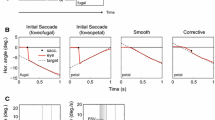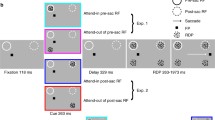Abstract
Saccade characteristics in response to moving and stationary targets were studied in three monkeys (Macaca mulatta) that had been trained to look at a target, which after an initial jump either remained in place or moved forward or backward with constant velocity (10°/s). Eye movements were recorded using a search coil. The contribution of smooth pursuit to the saccade amplitude was small (<0.25°). Saccades having the same amplitude (5.67–6.83° for different monkeys) to forward and backward moving targets were compared. Peak velocity was higher (37–42°/s on average for different monkeys) and saccade duration was shorter (8–10 ms on average) for backward saccades than for forward saccades These differences were highly significant (t-test: P<0.001). Thus, forward and backward saccades are not on the same main sequence. This suggests that saccade dynamics are affected not only by the retinal position error but also by target motion. Further analysis revealed that saccade peak velocity mainly depends on the retinal position error, but saccade amplitude also depends on a stimulus-related velocity factor, which affects the saccade mainly during deceleration. This velocity factor could be retinal slip or target velocity, which was the same under our conditions. Our results experimentally support recent models that propose that the saccade acceleration in response to moving targets might be controlled by the superior colliculus, whereas the deceleration changes are fine-tuned by the cerebellum. This prediction must still be tested on a neuronal level.






Similar content being viewed by others
References
Bahill AT, Clark MR, Stark L (1975) Τhe main sequence, a tool for studying human eye movements. Math Biosci 24:191–204
Becker W, Jürgens R (1979) An analysis of the saccadic system by means of double step stimuli. Vision Res 19:967–983
Becker W (1989) The neurobiology of saccadic eye movements. Metrics. Rev Oculomot Res 3:13–67
Blohm G, Missal M, Lefevre P (2003) Interaction between smooth anticipation and saccades during ocular orientation in darkness. J Neurophysiol 89:1423–1433
Boyle R, Buttner U, Markert G (1985) Vestibular nuclei activity and eye movements in the alert monkey during sinusoidal optokinetic stimulation. Exp Brain Res 57:362–369
de Brouwer S, Missal M, Lefevre P (2001) Role of retinal slip in the prediction of target motion during smooth and saccadic pursuit. J Neurophysiol 86:550–558
de Brouwer S, Missal M, Barnes G, Lefevre P (2002) Quantitative analysis of catch-up saccades during sustained pursuit. J Neurophysiol 87:1772–1780
Churchland AK, Lisberger SG (2002) Gain control in human smooth-pursuit eye movements. J Neurophysiol 87:2936–2945
Dean P (1995) Modelling the role of the cerebellar fastigial nuclei in producing accurate saccades: the importance of burst timing. Neuroscience 68:1059–1077
Erkelens AJ, Sloot OB (1995) Initial directions and landing positions of binocular saccades. Vision Res 35:3297–3303
Fuchs AF, Robinson FR, Straube A (1993) Role of the caudal fastigial nucleus in saccade generation. I. Neuronal discharge pattern. J Neurophysiol 70:1723–1740
Fuchs AF, Robinson FR, Straube A (1994) Participation of the caudal fastigial nucleus in smooth-pursuit eye movements. I. Neuronal activity. J Neurophysiol 72:2714–2728
Gellman RS, Carl JR (1991) Motion processing for saccadic eye movements in humans. Exp Brain Res 84:660–667
Guan YF, Eggert T, Büttner U (2003) Analysis of saccades to stationary and moving targets in the monkey. Ann N Y Acad Sci 1004:385–388
Hays AV, Richmont BJ, Optican LM (1982) A Unix-based multiple process system for real-time data acquisition and control. Wescon Conf Proc 2:100–105
Helmchen C, Straube A, Buttner U (1994) Saccade-related activity in the fastigial oculomotor region of the macaque monkey during spontaneous eye movements in light and darkness. Exp Brain Res 98:474–482
Heywood S, Churcher J (1981) Saccades to step-ramp stimuli. Vision Res 21:479–490
Judge SJ, Richmond BJ, Chu FC (1980) Implantation of magnetic search coils for measurement of eye position: an improved method. Vision Res 20:535–538
Jürgens R, Becker W, Kornhuber HH (1981) Natural and drug-induced variations of velocity and duration of human saccadic eye movements: evidence for a control of the neural pulse generator by local feedback. Biol Cybern 39:87–96
Keller E, Johnsen SD (1990) Velocity prediction in corrective saccades during smooth-pursuit eye movements in monkey. Exp Brain Res 80:525–531
Keller EL, Gandhi NJ, Weir PT (1996) Discharge of superior collicular neurons during saccades made to moving targets. J Neurophysiol 76:3573–3577
Kleine JF, Guan YF, Langer S, Tchelidze T, Büttner U (2002) Discharge properties of saccade-related neurons in the oculomotor region of primate fastigial nucleus. Ann N Y Acad Sci 978:526–528
Klier EM, Wang H, Crawford JD (2001) The superior colliculus encodes gaze commands in retinal coordinates. Nat Neurosci 4:627–632
Krauzlis RJ, Miles FA (1996) Decreases in the latency of smooth pursuit and saccadic eye movements produced by the “gap paradigm” in the monkey. Vision Res 36:1973–1985
Lisberger SG (1998) Postsaccadic enhancement of initiation of smooth pursuit eye movements in monkeys. J Neurophysiol 79:1918–1930
Optican LM, Quaia C (2002) Distributed model of collicular and cerebellar function during saccades. Ann N Y Acad Sci 956:164–177
Quaia C, Lefevre P, Optican LM (1999) Model of the control of saccades by superior colliculus and cerebellum. J Neurophysiol 82:999–1018
Robinson DA (1975) Oculomotor control signals. In: Lennerstrand G, Bach-y-Rita P (eds) Basic mechanisms of ocular motility and their clinical implications. Pergamon, Oxford, pp 337–374
Robinson FR, Fuchs AF (2001) The role of the cerebellum in voluntary eye movements. Annu Rev Neurosci 24:981–1004
Robinson FR, Straube A, Fuchs AF (1993) Role of the caudal fastigial nucleus in saccade generation. II. Effects of muscimol inactivation. J Neurophysiol 70:1741–1758
Ron S, Vieville T, Droulez J (1989) Target velocity based prediction in saccadic vector programming. Vision Res 29:1103–1114
Scudder CA (1988) A new local feedback model of the saccadic burst generator. J Neurophysiol 59:1455–1475
Scudder CA, Kaneko CS, Fuchs AF (2002) The brainstem burst generator for saccadic eye movements: a modern synthesis. Exp Brain Res 142:439–462
Smeets J, Bekkering H (2000) Prediction of saccadic amplitude during smooth pursuit eye movements. Hum Movement Sci 19:275–295
Yamada J, Noda H (1987) Afferent and efferent connections of the oculomotor cerebellar vermis in the macaque monkey. J Comp Neurol 265:224–241
Acknowledgements
The authors are grateful to Ms. S. Langer for technical assistance, Dr. E.W. Roubos for his valuable advice, Ms. B. Pfreundner and Ms. I. Wendl for preparing the manuscript, and Ms. J. Benson for copyediting the English text. This work was supported by the Deutsche Forschungsgemeinschaft (SFB 462).
Author information
Authors and Affiliations
Corresponding author
Additional information
Both Yanfang Guan and Thomas Eggert contributed equally
Rights and permissions
About this article
Cite this article
Guan, Y., Eggert, T., Bayer, O. et al. Saccades to stationary and moving targets differ in the monkey. Exp Brain Res 161, 220–232 (2005). https://doi.org/10.1007/s00221-004-2070-3
Received:
Accepted:
Published:
Issue Date:
DOI: https://doi.org/10.1007/s00221-004-2070-3




